Speaking at Defcamp posted November 2017
I'll be at Defcamp talking about SHA-3 (the standard), as well as its derived functions and protocols. It's happening next week in Bucharest. If you're around there hit me up!


Hey! I'm David, cofounder of zkSecurity and the author of the Real-World Cryptography book. I was previously a crypto architect at O(1) Labs (working on the Mina cryptocurrency), before that I was the security lead for Diem (formerly Libra) at Novi (Facebook), and a security consultant for the Cryptography Services of NCC Group. This is my blog about cryptography and security and other related topics that I find interesting.
Quick access to articles on this page:
more on the next page...
I'll be at Defcamp talking about SHA-3 (the standard), as well as its derived functions and protocols. It's happening next week in Bucharest. If you're around there hit me up!

warning: as this is a proof of concept to see if 4chan could be implemented on the blockchain, some people might post shocking pictures or videos on there. At the time of the writing nothing "bad" has happened, but take precautions if you're planning to take a look at it :)
This is part II of Writing a DAPP for the Ethereum block chain I guess (where I previously said I would not publish this smart contract on the main network).
Pulling the entire Ethereum blockchain took me all afternoon. The thing is taking 29GB of disk space at the moment.
I sent ~20USD worth of ether (0.10 ether) from Coinbase to my real Mist wallet and prepared to see how much it would cost to deploy my smart contract. Surprisingly it was cheap! It cost me 0.007715952 ETHER which is ~2USD (around 1 million unit of gas at 0.008 ether per million gas) to deploy my contract to 0x470fb19D08c3d2eB8923A31d1408c393Dab09ccF an address computed out of my keypair and a nonce. I do not own its associated private key because I simply will never need it.
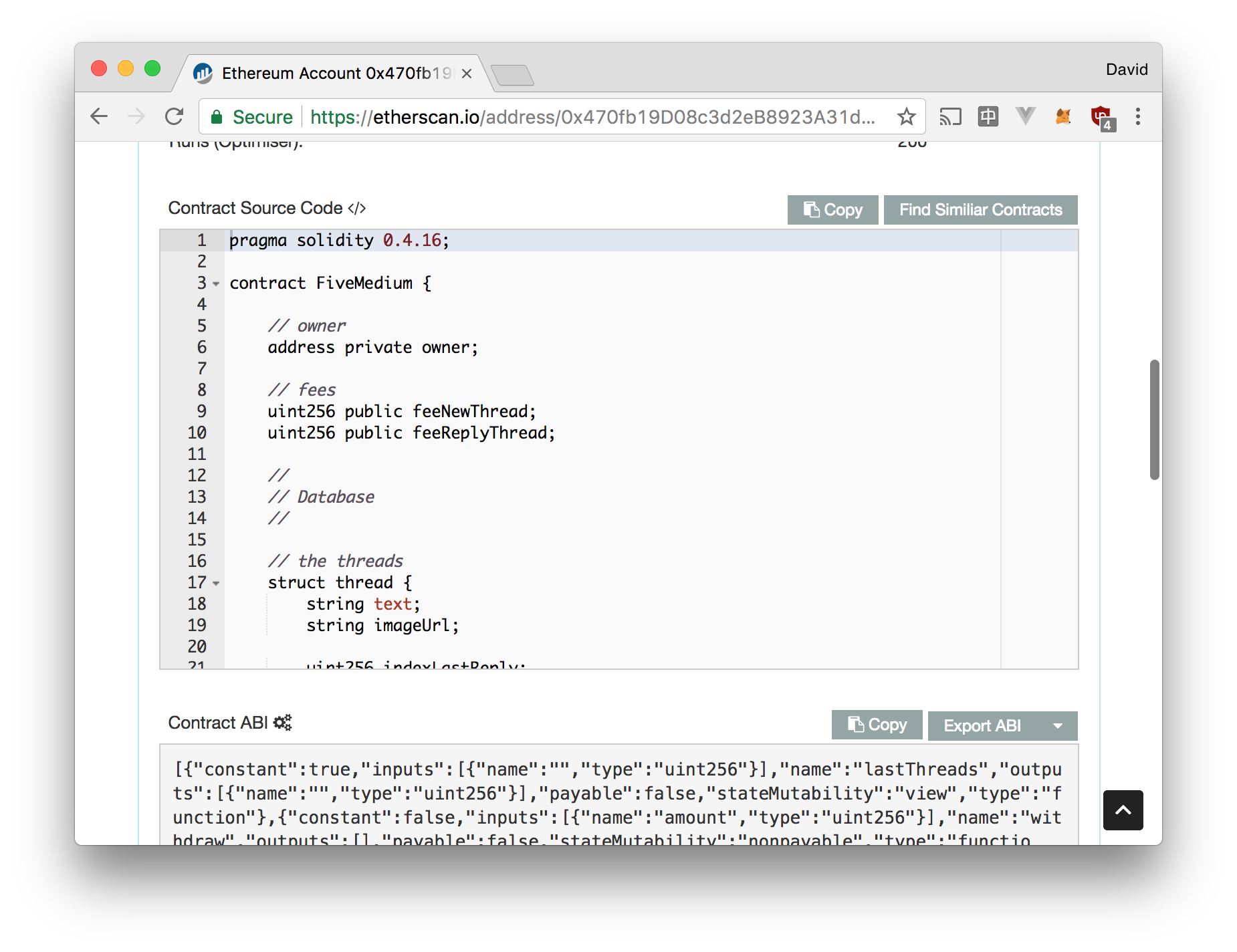
To make sure the smart contract's code was properly open sourced on etherscan.io I had to put the source code there and provide the used compiler's version and the ABI encoded arguments to the controller. The ABI encoded arguments are just the 0-padded hexadecimal encoing of the arguments. I had two uint256 as arguments to my FiveMedium() constructor: the fee to post a thread and the fee to reply to a thread.
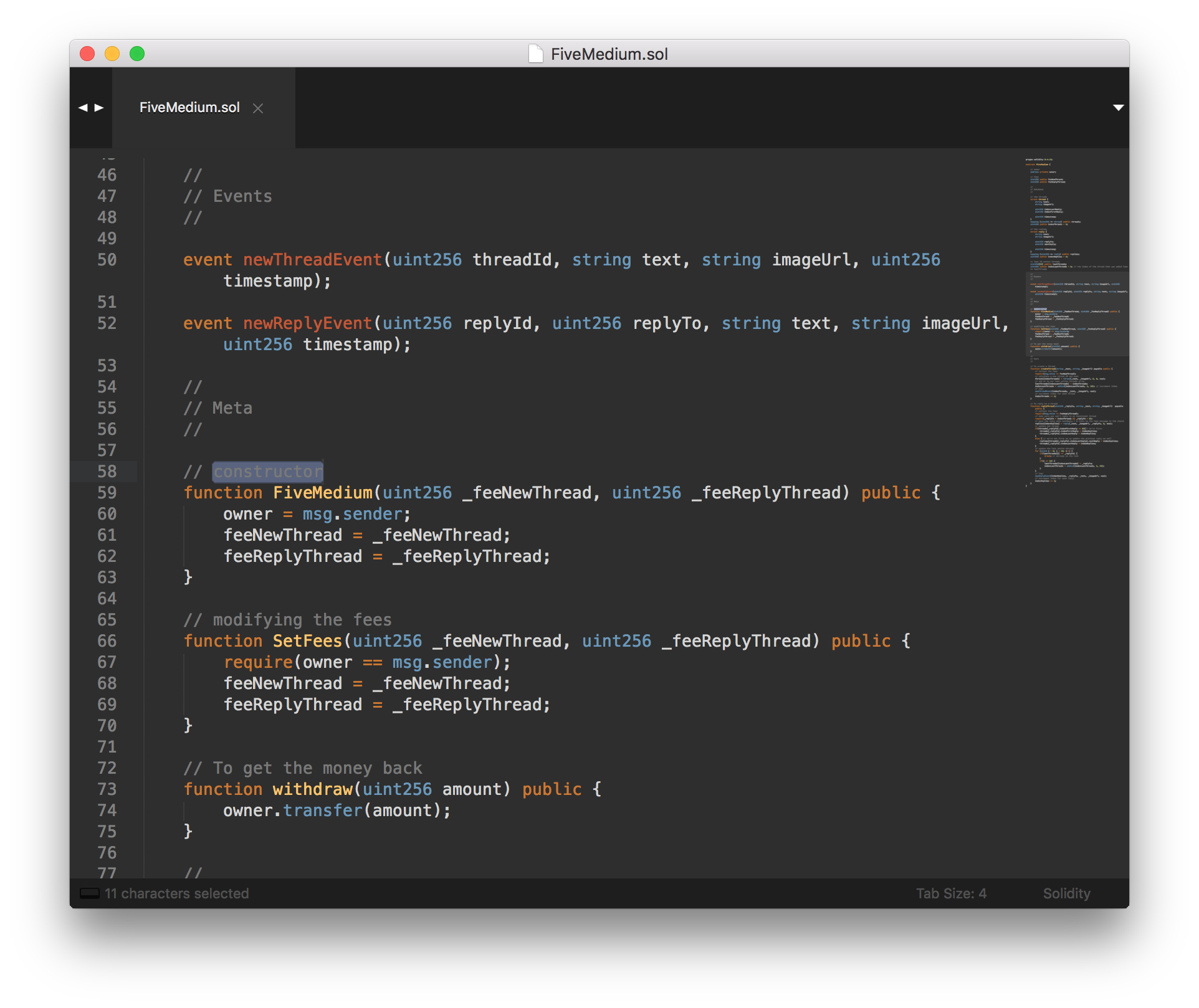
I decided to set the creation of a thread around 1$ and replying to a thread around 10 cents. It was then time to push the button and publish it.
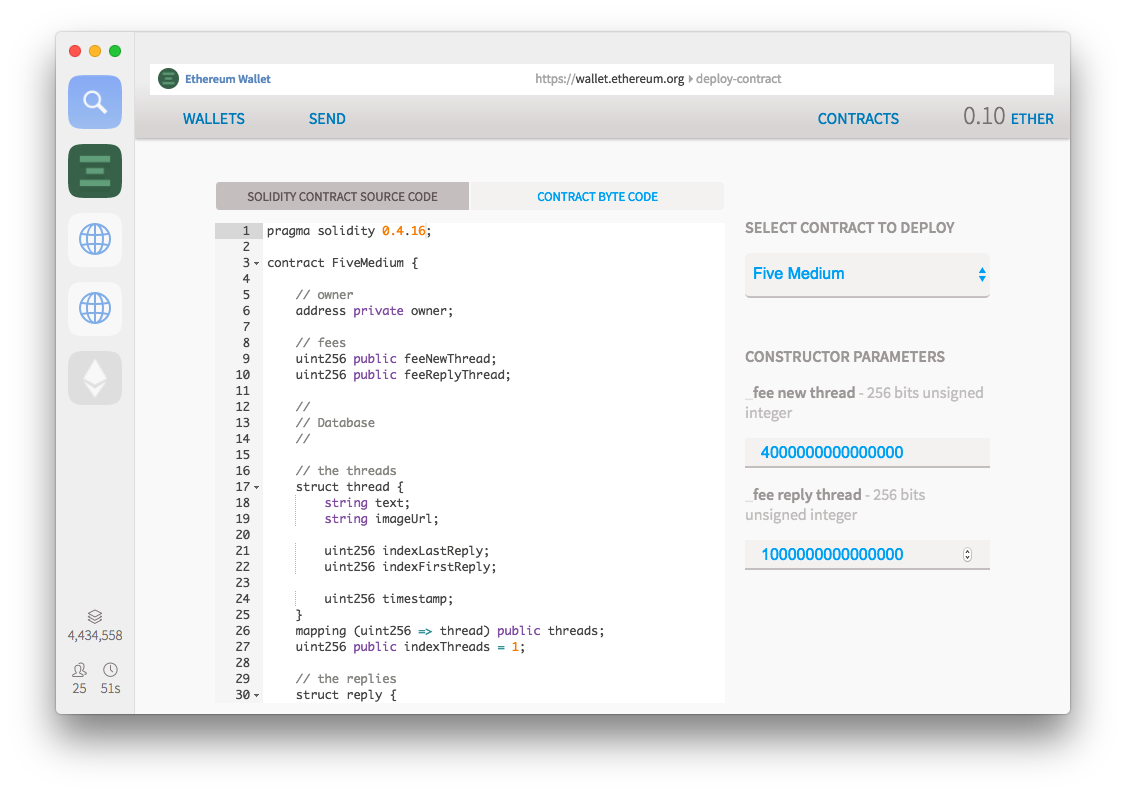
And voila! You can access the DAPP on davidwong.fr/FiveMedium.
Note: the mandatory gas cost to post or reply on a thread seems to be around 0.30$. This has influenced me to lower down the contract fees to approach the gas fees.
2 commentswarning: as this is a proof of concept to see if 4chan could be implemented on the blockchain, some people might post shocking pictures or videos on there. At the time of the writing nothing "bad" has happened, but take precautions if you're planning to take a look at it :)
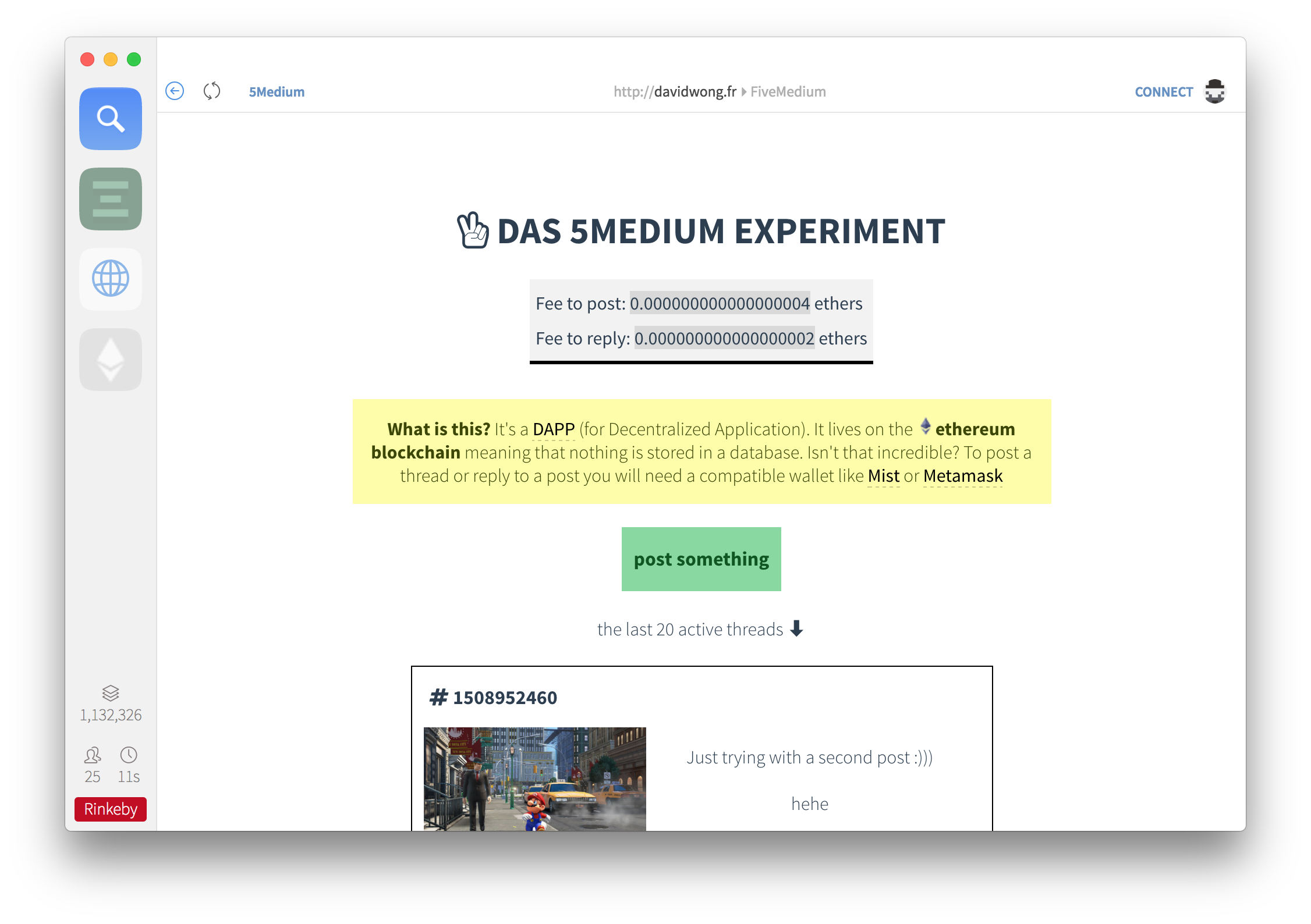
I've been dabbing in smart contract security (see my video here) and I found it natural to try and do a DAPP (decentralized application) myself. How hard can it be?
3.5 days later I've got back into Javascript after many years; I've learned Vue.js (kind of, my code is really ugly) and I've created my first DAPP!
First thing I'll have to say: it's hella fun.
Javascript has gone a long way and the Vue.js framework is just great! I've tried using React but I found it less developer-friendly, harder to learn and lacking in terms of template. It just didn't click. I guess coming from HTML first (and jQuery later) the Vue.js framework just makes more sense to me. It's all about having fun and I wasn't having any with React.
I still want to create, modify and query things the jQuery way, but I'm getting used to the javascript modernities (querySelector, arrow functions, ...) and the Vue.js way. I like it. It will take some time to get rid of my old habits and re-think the way I write front end code but I like it.
Writing the smart contract is quite straight forward. It's 128 lines of Solidity code, but most of it are comments (yes I comment my code). At one point I should publish it on etherscan.io because this is best practice. It's not compiled with the last version of Solidity (boooo!) because I deployed it via Mist and Mist doesn't have the last version of Solidity.

Writing the dapp with Vue.js and the web3.js API (the javascript library to interact with the blockchain via an ethereum node) is pretty straight forward as well. The learning curve is not bad and there are tons of resources for beginners. That is, until you test your dapp with a real wallet like the Metamask wallet (integrated as a browser plugin) or the official Mist wallet (Electron app). Different wallets offer different functions and versions of web3 (how it works: they inject the web3 object in your document and you can use it directly from your javascript webapp). They also (for the most part) refuse any synchronous calls on the web3 API without really providing ways for you to debug what is not synchronous in your call. A lot of functions have to be replaced for the asynchronous variants, any async/await has to disappear and you enter callback hell. Not fun.
The worst is that the documentation gets sparser and sparser as you enter the world of real DAPPs. You understand that things are changing really fast, that wallets will soon stop supporting web3.js and that a real API will be provided at some point. Everything is way more experimental than I had thought.
On top of that, Metamask doesn't let you watch for events yet, so say goodbye to your DAPP being "live" for their users.
To make the app offline, meaning browsable without a wallet, I use Infura. You basically just have to switch the url of the node to the ones Infura gives you, and web3 will be able to interact with it the same way it interacts with a real node. This is because the standard works via normal Json-RPC routes using the Json way to structure queries and responses. Unfortunately, like Metamask, Infura doesn't let you listen to events so the app is browsable, but not live.
I haven't taken the time to publish the smart contract on the real ethereum network yet. It's sitting on Rinkeby which is a test network where you can get ethers for free. I'm not going to get rich on a test network, and some of my friends are eyeballing me for this decision (I see you jc) but this is fun and I want people to try it for free :)
Is it hard? No but it's annoying. First I need to pull up the whole Ethereum blockchain.
As of April 19th, 2017, my blockchain size is 23.5 GB total.
from this Quora answer
Second, I need some ethers, and buying ethers from the UK is hard. Of course I already have some (I wouldn't be writing anything about ethereum if I wasn't invested), but I had to go through weeks of research to buy them. (If you're looking for an easy way, learn from my wasted time: transfer money on a Revolut account, change it to euro, do a free SEPA transfer to Kraken, buy ethers there.)
Anyone can replicate my work. The DAPP is client-side code (javascript) so anyone can download it and run it on their own page. the contract is also up there on the blockchain, it's public stuff. I don't really like this, but it is how Ethereum works. If I someday drop the page from the internet, anyone can get it and run it. Run it on their own server, but also run it locally from their own machine.
If you want to see how it works without getting a wallet:
But I recommend you to give a try to this new technology!
Download Mist, set the network to Rinkeby, grab some free ethers from the faucet there and browse to my DAPP FiveMedium.
Have fun!
PS: yes this is heavily inspired by 4chan.
2 commentsI just made a video covering common attacks on Ethereum's smart contracts. I used live0verflow's techniques to record and edit this one so it's going to feel different from the others :) It's a tl;dr of A survey of attacks on Ethereum smart contracts by Nicola Atzei and Massimo Bartoletti and Tiziana Cimoli.
ps: many thanks to Matthew Di Ferrante for the help!
comment on this storyI've polished the design of this blog a bit (with flexbox and css-grid!) and it should look a bit cleaner :)
I've also created a page for graphics. I only have 3 at the moment, but I know that PHD students often present posters like these at conferences so if you know any (or if you have one yourself) and you want me to showcase it there send me a message!
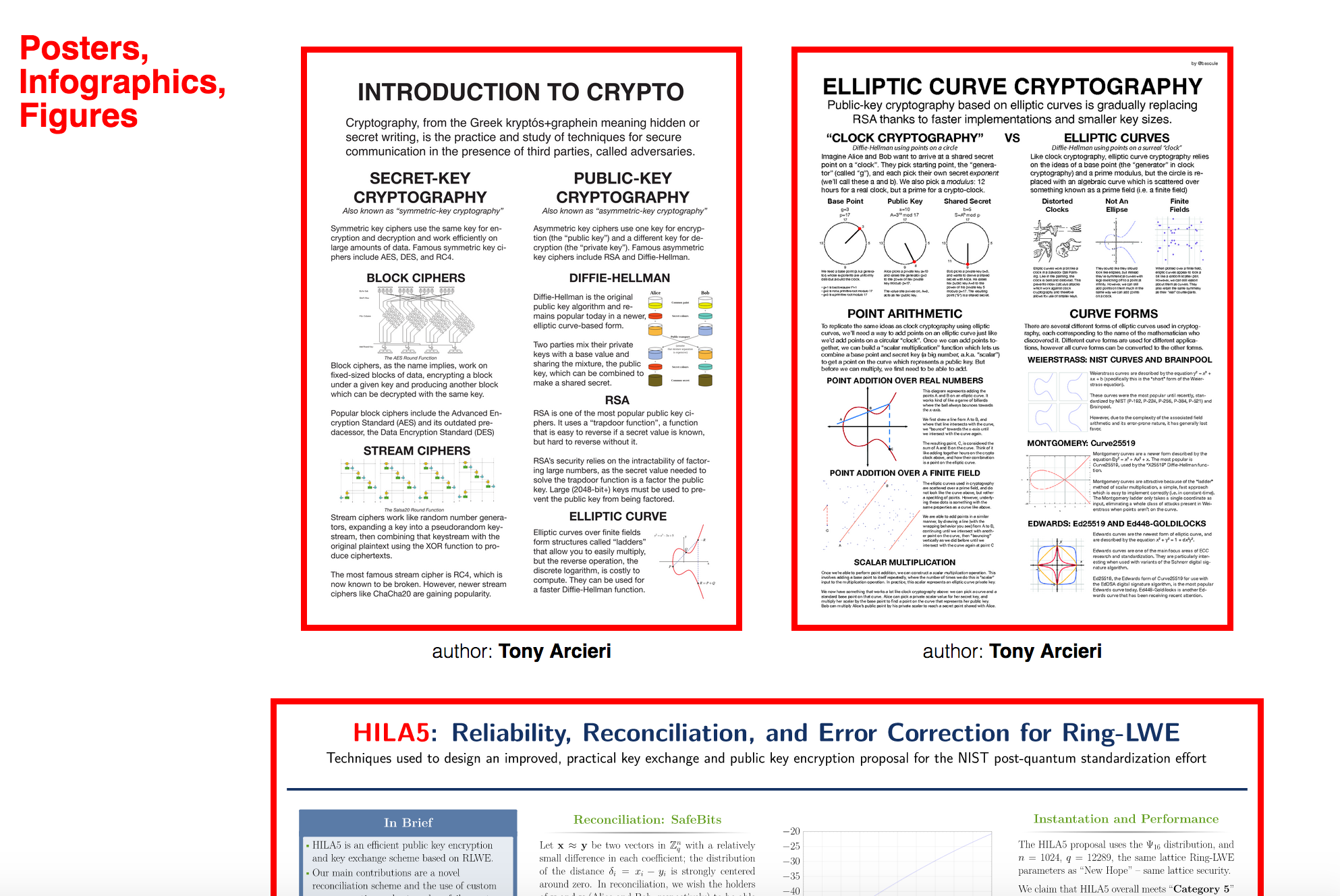
I'm giving a talk at Black Hat Europe in a few months, and thus I was given two tickets for students to come attend the conference for free.
Anyone interested?
EDIT: no more tickets! If you really want to go to Black Hat, I'd advise you to contact directly other speakers as every BH speaker is given 2 free pass for students.
1 commentIn my quest to understand Go Assembly better, I forked Go by Example and created my own version for Go Assembly.
You can check it out here, and someone already translated it in Chinese here.
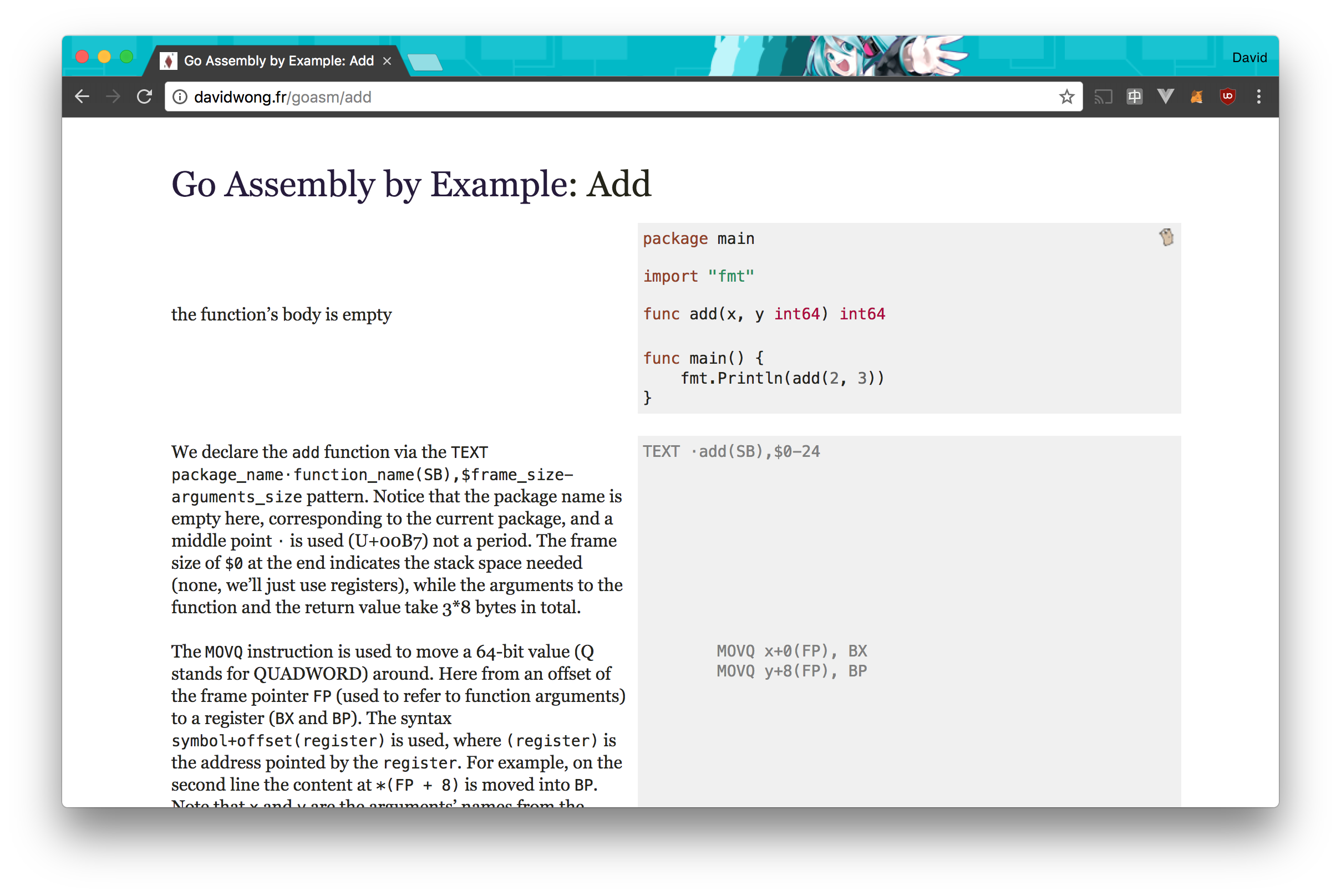
tl;dr: use this code
When a program uses a secret key for some cryptographic operation, it will store it somewhere in memory. This is a problem because it is trivial to read what has been previously stored in memory from a different program, just create something like this:
#include <stdio.h>
int main(){
unsigned char a[5000];
for(int i = 0; i < 10000; i++) {
printf("x", a[i]);
}
printf("\n");
}This will print out whatever was previously there in memory, because the buffer a is not initialized to zeros. Actually, C seldom initializes things to zeros, it can if you specifically use something like calloc instead of malloc or static in front of a global variable/struct/...
EDIT: as Fred Akalin pointed to me, it looks like this is fixed in most modern OS. Colin Perceval notes that there are other issues with not zero'ing memory:
if someone is able to exploit an unrelated problem — a vulnerability which yields remote code execution, or a feature which allows uninitialized memory to be read remotely, for example — then ensuring that sensitive data (e.g., cryptographic keys) is no longer accessible will reduce the impact of the attack. In short, zeroing buffers which contained sensitive information is an exploit mitigation technique.
This is a problem.
To remove a key from memory, developers tend to write something like this:
memset(private_key, 0, sizeof(*private_key));Unfortunately, when the compiler sees something like this, it will remove it. Indeed, this code is useless since the variable is not used anymore after, and the compiler will optimize it out.
How to fix this issue?
A memset_s function was proposed and introduced in C11. It is basically a safe memset (you need to pass in the size of the pointer you're zero'ing as argument) that will not get optimized out. Unfortunately as Martin Sebor notes:
memset_s is an optional feature of the C11 standard and as such isn't really portable. (AFAIK, there also are no conforming C11 implementations that provide the optional Annex K in which the function is defined.)
To use it, a #define at the right place can be used, and another #define is used as a notice that you can now use the memset_s function.
#define __STDC_WANT_LIB_EXT1__ 1
#include <string.h>
#include <stdlib.h>
// ...
#ifdef __STDC_LIB_EXT1__
memset_s(pointer, size_data, 0, size_to_remove);Unfortunately you cannot rely on this for portability. For example on macOS the two #define are not used and you need to use memset_s directly.
Martin Sebor adds in the same comment:
The GCC -fno-builtin-memset option can be used to prevent compatible compilers from optimizing away calls to memset that aren't strictly speaking necessary.
Unfortunately, it seems like macOS' gcc (which is really clang) ignores this argument.
What else can we do?
I asked Robert Seacord who always have all the answers, here's what he gave me in return:
void *erase_from_memory(void *pointer, size_t size_data, size_t size_to_remove) {
if(size_to_remove > size_data) size_to_remove = size_data;
volatile unsigned char *p = pointer;
while (size_to_remove--){
*p++ = 0;
}
return pointer;
}Does this volatile keyword works?
Time to open gdb (or lldb) to verify what the compiler has done. (This can be done after compiling with or without -O1, -O2, -O3 (different levels of optimization).)
Let's write a small program that uses this code and debug it:
int main(){
char a[6] = "hello";
printf("%s\n", a);
erase_from_memory(a, 6, 6);
}
mainmain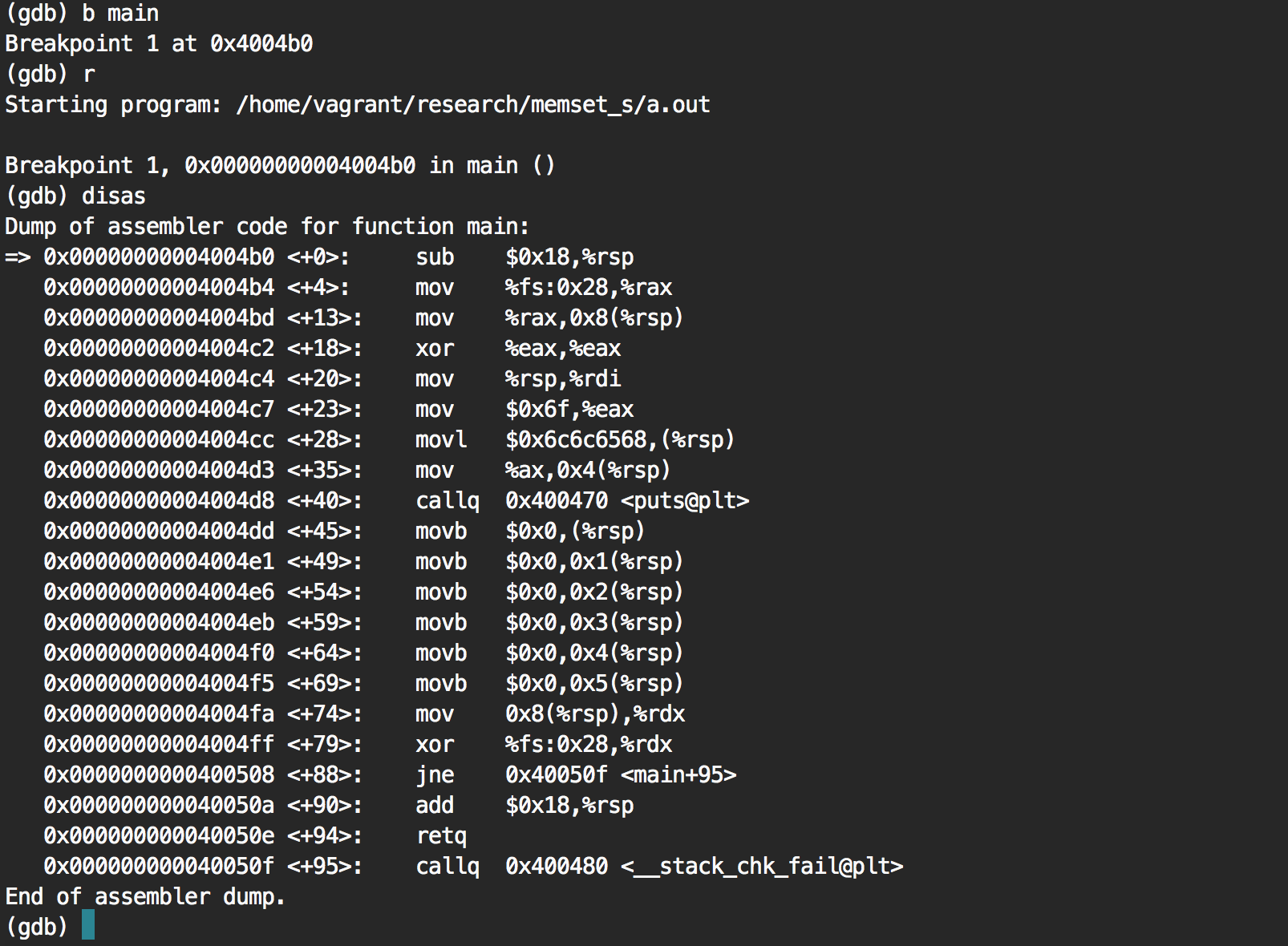
We notice a bunch of movb $0x0 ...
Is this it? Let's put a breakpoint on the first one and see what the stack pointer (rsp) is pointing to.

It's pointing to the string "hello" as we guessed.

Going to the next instruction via ni, we can then see that the first letter h has been removed. Going over the next instructions, we see that the full string end up being zero'ed.

It's a success!
The full code can be seen here as an erase_from_memory.h header file that you can just include in your codebase:
#ifndef __ERASE_FROM_MEMORY_H__
#define __ERASE_FROM_MEMORY_H__ 1
#define __STDC_WANT_LIB_EXT1__ 1
#include <stdlib.h>
#include <string.h>
void *erase_from_memory(void *pointer, size_t size_data, size_t size_to_remove) {
#ifdef __STDC_LIB_EXT1__
memset_s(pointer, size_data, 0, size_to_remove);
#else
if(size_to_remove > size_data) size_to_remove = size_data;
volatile unsigned char *p = pointer;
while (size_to_remove--){
*p++ = 0;
}
#endif
return pointer;
}
#endif // __ERASE_FROM_MEMORY_H__Many thanks to Robert Seacord!
PS: here is how libsodium does it
EDIT: As Colin Percival wrote here, this problem is far from being solved. Secrets can get copied around in (special) registers which won't allow you to easily remove them.
11 comments
My book Real-World Cryptography is finished and shipping! You can purchase it here.
If you don't know where to start, you might want to check these popular articles:
Here are the latest links posted:
You can also suggest a link.